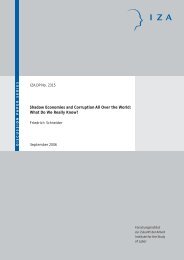Health Outcomes and Socio-Economic Status among ... - Index of - IZA
Health Outcomes and Socio-Economic Status among ... - Index of - IZA
Health Outcomes and Socio-Economic Status among ... - Index of - IZA
Create successful ePaper yourself
Turn your PDF publications into a flip-book with our unique Google optimized e-Paper software.
CHARLS followed the HRS example <strong>and</strong> asked respondents to assess their general health<br />
using two different scales: excellent, very good, good, fair, poor <strong>and</strong> very good, good, fair, poor,<br />
very poor. One was asked at the start <strong>of</strong> the health section, section CA, <strong>and</strong> one at the end <strong>of</strong> that<br />
section. Whether a respondent was asked one or the other first was determined r<strong>and</strong>omly by<br />
CAPI. Here we use the excellent, very good, good, fair, poor scale. We look at whether<br />
respondents report poor health, as our variable <strong>of</strong> interest. About 19% <strong>of</strong> men <strong>and</strong> 27% <strong>of</strong><br />
women report that they are in poor health. The fraction <strong>of</strong> respondents reporting fair health is<br />
quite high, 40%. This is one reason why we do not combine fair <strong>and</strong> poor health as is done <strong>of</strong>ten<br />
in US studies. Apparently “fair” translates in Chinese to a word which is very commonly<br />
answered.<br />
Figure 9 shows the bivariate relationship with education. As expected, better educated<br />
men <strong>and</strong> women report less being in poor health. The male-female differences narrow with the<br />
by education results because at each level <strong>of</strong> education, men are older than women.<br />
Table 12 shows regression results for men <strong>and</strong> women. For men, education is not<br />
significantly related to reporting being in poor health, but pce is, negatively. The pce relation is<br />
non-linear, with pce making most if its difference at higher levels <strong>of</strong> pce. Note, once again, that<br />
when province-rural/urban dummies are added, or when community fixed effects are used, that<br />
the pce coefficients move towards zero <strong>and</strong> are not significant.<br />
For women, the pce results are qualitatively similar to the male results. Education<br />
dummies are now significant, being negatively correlated with reporting being in poor health.<br />
However, when the province or community dummies are added only the junior high or above<br />
retains its significant correlation, <strong>and</strong> the coefficients collapse with both province-urban/rural<br />
dummies <strong>and</strong> community fixed effects significant. Respondents living in Gansu province are<br />
25
















